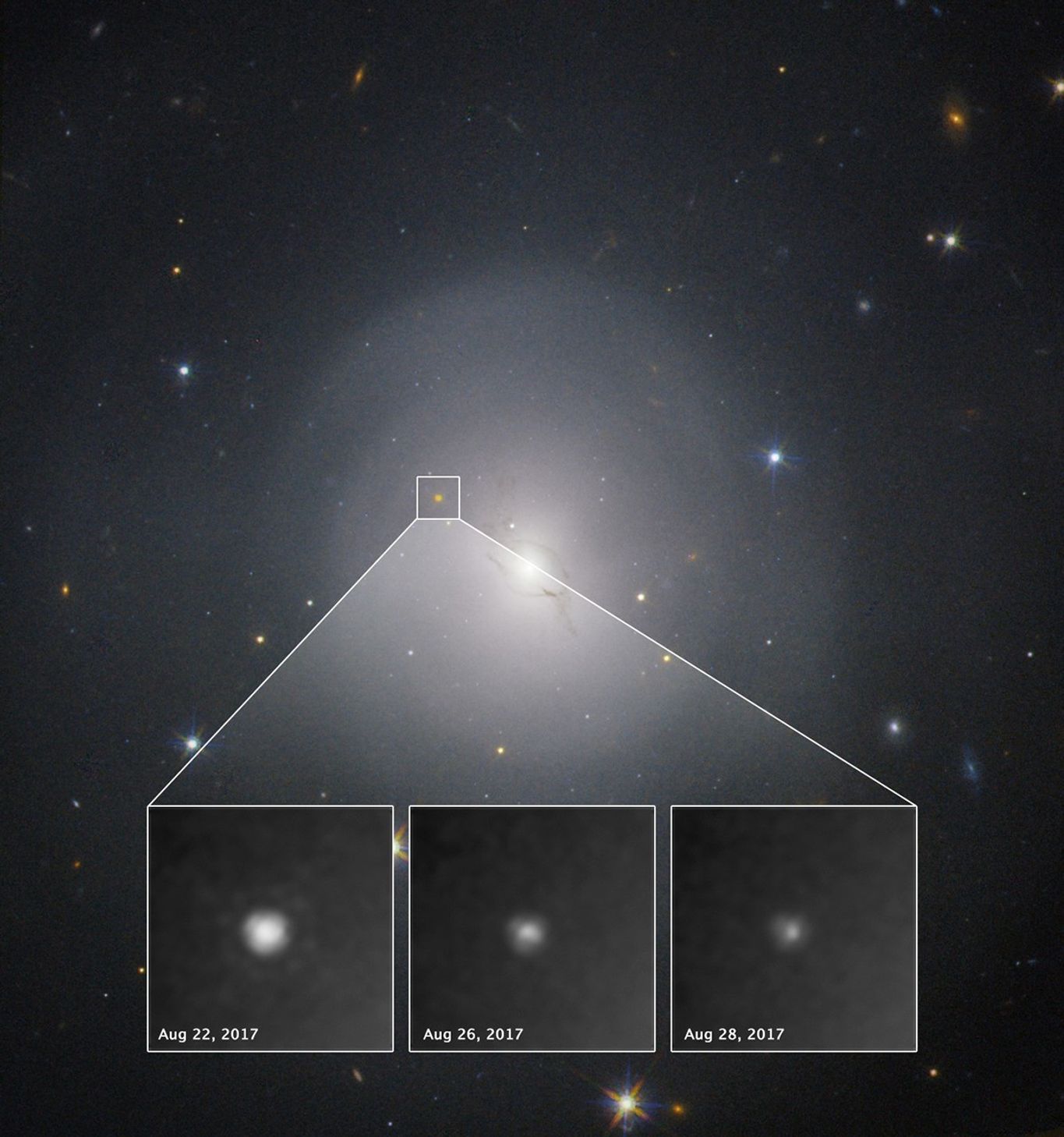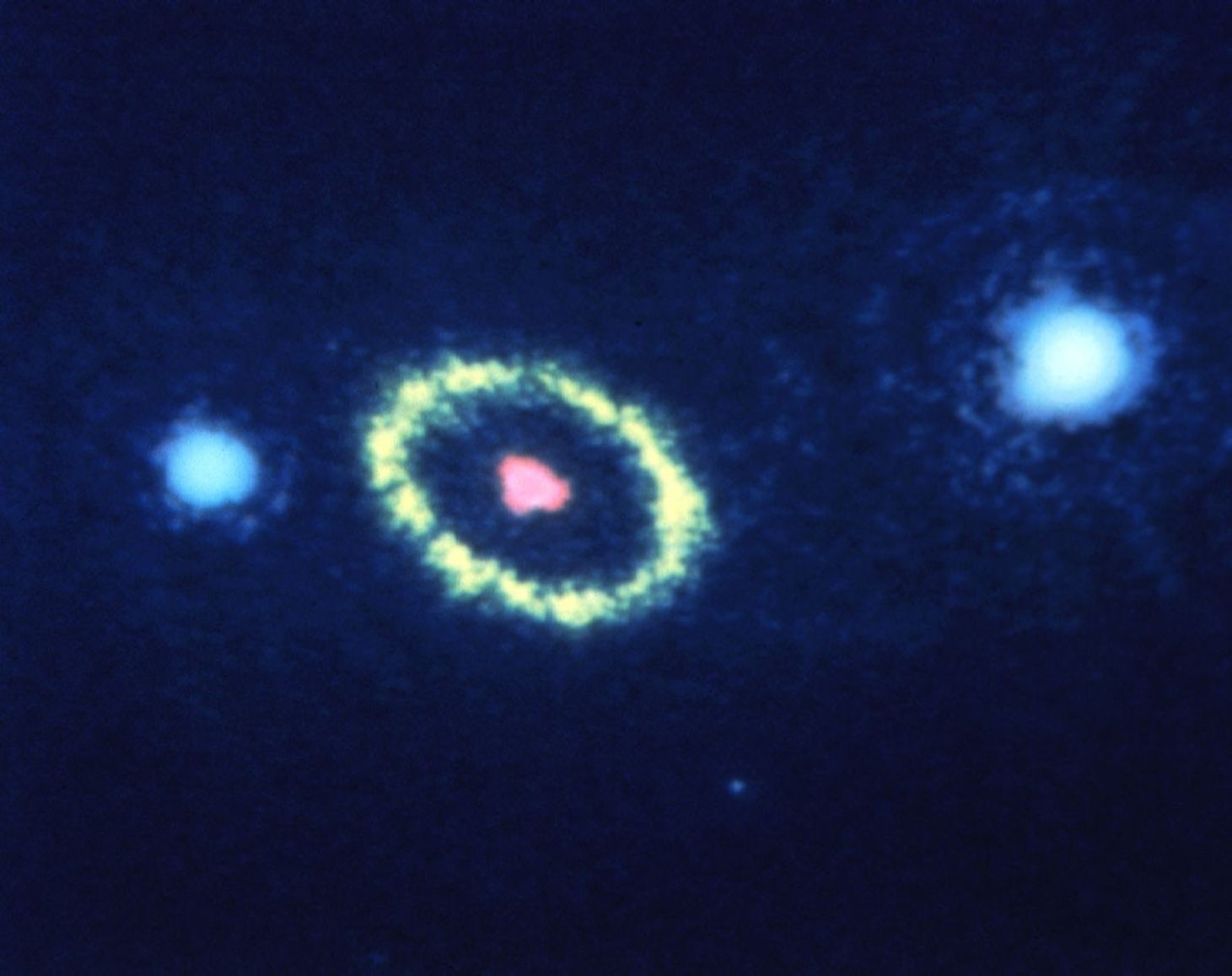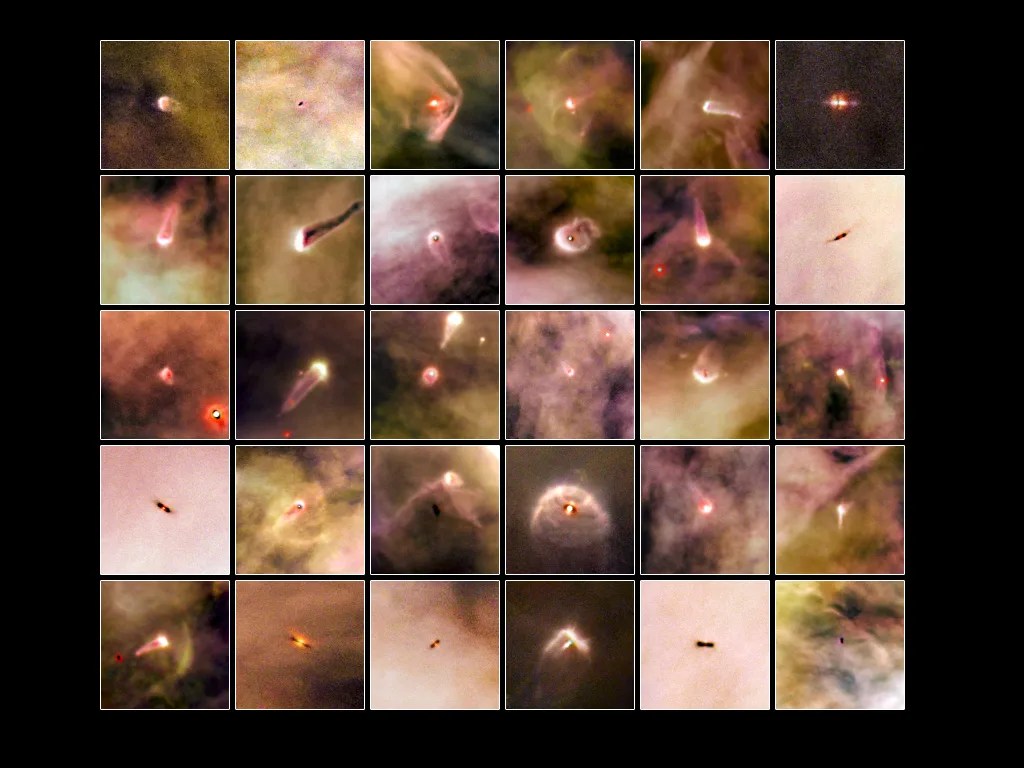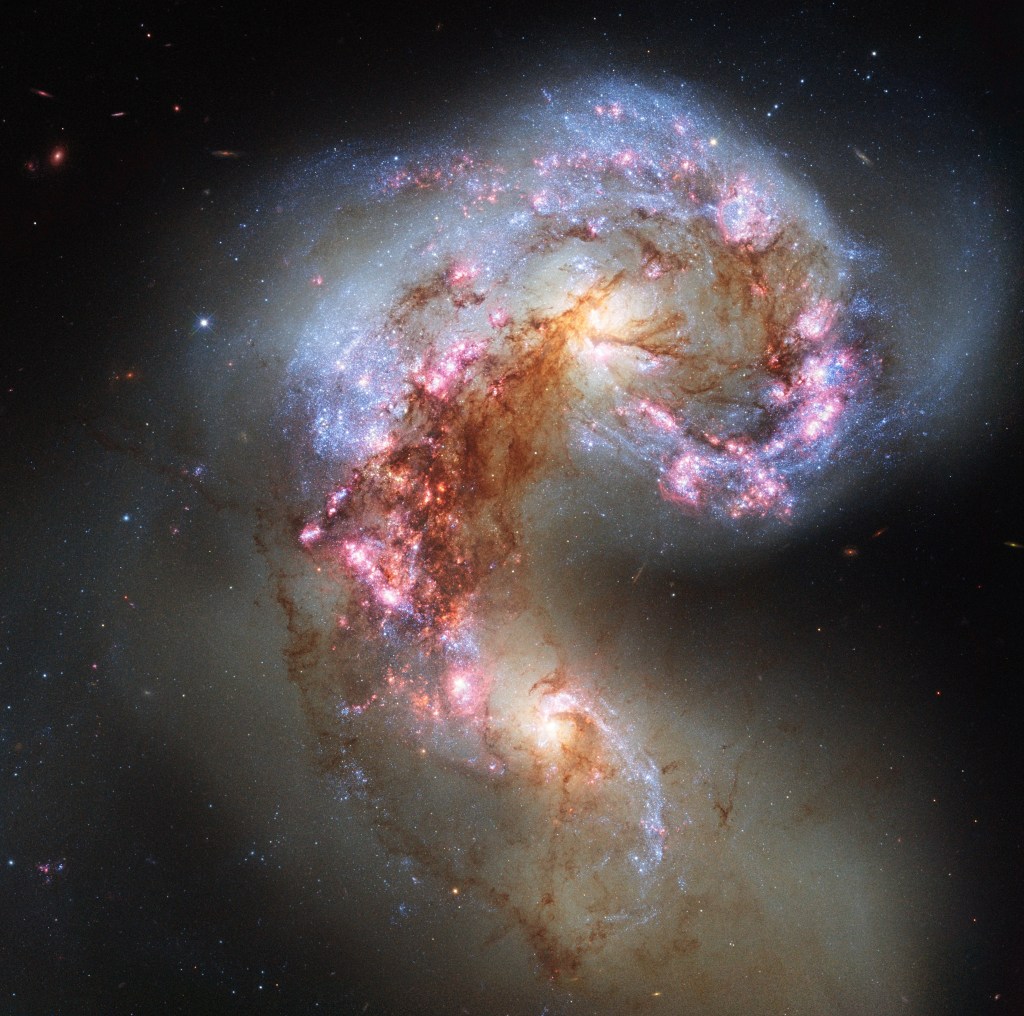For decades, astronomers pondered the source of one of the most energetic and mysterious events in the universe, gamma-ray bursts (GRB). In a few seconds, GRBs can emit more energy than the Sun over its entire 10-billion-year life. It wasn’t until Hubble began observing the visible source of these events that astronomers began to better understand their origins.
-
Gamma-Ray Bursts
In 1997, astronomers employed Hubble's high resolution and sensitivity to hunt down a rapidly dimming fireball in the region of space that had produced a GRB. The explosive remnant rapidly faded, and ground-based observatories could no longer see it. Hubble observations allowed astronomers to continue following the fading source, and clearly showed that it had two components: a point-like object and an extended feature.
Hubble Tracks the Fading Optical Counterpart of a Gamma-Ray Burst
 Gamma-Ray Burst 990123NASA
Gamma-Ray Burst 990123NASA -
Soon after the GRB 990123 observations, Hubble’s Wide Field and Planetary Camera 2 captured the first visible light image that associates a gamma-ray burst source with a potential host galaxy. The bright source was not near the center of the galaxy – which might have suggested it came from a black hole at the galaxy’s heart – but on the outskirts.
Gamma-Ray Bursts Common To Normal Galaxies? Hubble Data Offer New Clues and Puzzles
 Gamma-Ray Bburst 970228NASA, K. Sahu, M. Livio, L. Petro, D. Macchetto, and STScI
Gamma-Ray Bburst 970228NASA, K. Sahu, M. Livio, L. Petro, D. Macchetto, and STScI -
Kilonovae
On June 13, 2013, Hubble observed a rapidly fading fireball produced in the aftermath of GRB 130603B, whose initial blast lasted only one-tenth of a second. The Hubble observation revealed a new kind of stellar blast called a kilonova, an explosion that astronomers predicted would accompany short-duration GRBs. This kilonova provided strong evidence that short-duration gamma-ray bursts are the result of a merger of two small, super-dense stellar objects, such as a pair of neutron stars or a neutron star and a black hole.
 Gamma-Ray Burst 130603BNASA, ESA, N. Tanvir (University of Leicester), A. Fruchter (STScI), and A. Levan (University of Warwick)
Gamma-Ray Burst 130603BNASA, ESA, N. Tanvir (University of Leicester), A. Fruchter (STScI), and A. Levan (University of Warwick) -
Then, in August 2017, Hubble was part of a team of observatories that observed a kilonova explosion accompanying the merger of two neutron stars and the related gravitational waves. Seventy observatories around the globe observed the merger’s aftermath. Hubble’s precise measurements allowed astronomers to pinpoint the explosion site and revealed the speed of a jet moving at least 99.97% the speed of light.
NASA Missions Catch First Light from a Gravitational-Wave Event
 Kilonova in NGC 4993NASA and ESA Acknowledgment: A. Levan (U. Warwick), N. Tanvir (U. Leicester), and A. Fruchter and O. Fox (STScI)
Kilonova in NGC 4993NASA and ESA Acknowledgment: A. Levan (U. Warwick), N. Tanvir (U. Leicester), and A. Fruchter and O. Fox (STScI) -
Today, thanks in large part to Hubble observations, astronomers categorize GRBs into two types: Long GRBs (where the initial burst lasts two seconds or longer) and Short GRBs (where the burst lasts less than two seconds). Short bursts are associated with the collision of either two neutron stars or a neutron star and a black hole. Long bursts stem from the explosive, supernova deaths of massive stars.
 Gamma-Ray Burst 080319BNASA, ESA, N. Tanvir (University of Leicester), and A. Fruchter (STScI)
Gamma-Ray Burst 080319BNASA, ESA, N. Tanvir (University of Leicester), and A. Fruchter (STScI) -
Supernovae
Hubble’s observations of supernovae have also played a key role in our understanding of these explosive star deaths. Its first observations of a supernova came just four months after its launch, when Hubble’s Faint Object Camera resolved an elliptical ring of material around the remnants of Supernova 1987A (SN1987A).
Hubble Space Telescope Resolves Gaseous Ring Around Supernova
 SN1987a (August 1990)NASA, ESA, and STScI
SN1987a (August 1990)NASA, ESA, and STScI -
SN 1987A was the brightest exploding star astronomers saw in 400 years. Hubble’s sensitivity, resolution, and longevity allow it to keep track of SN1987a’s evolution, collecting 7,000 data sets for some 250 scientific proposals as of July 2024. This data revealed rings in different planes in 1994. The bright central ring is about one light-year across and existed when the star exploded. The star likely shed the ring thousands of years before it went supernova. Ultraviolet radiation from the exploding star caused it to glow in early Hubble images. As the gas cooled, the ring faded until the blast’s shock wave reached the ring causing it to brighten again.
 This photo album of Hubble images shows a ring of gas beginning to glow around SN1987A.NASA, ESA, P. Challis and R. Kirshner (Harvard-Smithsonian Center for Astrophysics)
This photo album of Hubble images shows a ring of gas beginning to glow around SN1987A.NASA, ESA, P. Challis and R. Kirshner (Harvard-Smithsonian Center for Astrophysics) -
Astronomers found evidence of a hypothesized electron-capture supernova by comparing a Hubble image of the supernova, called SN 2018zd, with earlier Hubble images of the same area of sky. This allowed them to identify the supernova’s progenitor star in the galaxy NGC 2146. Stars between eight and 10 times the mass of the Sun theoretically should explode in a different way. Their immense internal pressure would force electrons to fuse with atomic nuclei, causing a sudden drop in electron pressure that triggers the collapse and subsequent explosion of the star’s surrounding layers.
Stellar Explosion in 1054 C.E. May Have Been a Third Flavor of Supernova
 Composite Image of NGC 2146 and SN 2018zd (bright spot on the right)NASA, J. DePasquale (STScI), and Las Cumbres Observatory
Composite Image of NGC 2146 and SN 2018zd (bright spot on the right)NASA, J. DePasquale (STScI), and Las Cumbres Observatory -
In April 2020, astronomers discovered a supernova inside the interacting Butterfly galaxies (NGC 4568). They quickly trained Hubble on the aftermath and got a ringside view of the supernova in the very earliest stage of exploding. Hubble viewed a region very close to the supernova, examining material ejected by the star in the last year of its life. These observations may provide astronomers with an early warning system for other stars on the brink of an explosive death.
Hubble Gives Unprecedented, Early View of a Doomed Star’s Destruction
 SN 2020fqv in NGC 4568NASA, ESA, Ryan Foley (UC Santa Cruz) Image; Image Processing: Joseph DePasquale (STScI)
SN 2020fqv in NGC 4568NASA, ESA, Ryan Foley (UC Santa Cruz) Image; Image Processing: Joseph DePasquale (STScI)
Learn More
Hubble Science Highlights
Discover the breadth and depth of Hubble's exciting discoveries!

Studying the Planets and Moons
Hubble’s systematic observations chart the ever-changing environments of our solar system's planets and their moons.

Tracking Evolution in the Asteroid Belt
These conglomerates of rock and ice may hold clues to the early solar system.

Uncovering Icy Objects in the Kuiper Belt
Hubble’s discoveries helped NASA plan the New Horizon spacecraft’s flyby of Pluto and beyond.

Exploring the Birth of Stars
Seeing ultraviolet, visible, and near-infrared light helps Hubble uncover the mysteries of star formation.

The Death Throes of Stars
When stars die, they throw off their outer layers, creating the clouds that birth new stars.

Finding Planetary Construction Zones
Hubble’s sensitivity uncovers the seeds of planets in enormous disks of gas and dust around stars.

Recognizing Worlds Beyond Our Sun
Hubble can detect and measure the basic organic components for life on planets orbiting other stars.

Seeing Light Echoes
Like ripples on a pond, pulses of light reverberate through cosmic clouds forming echoes of light.

Tracing the Growth of Galaxies
Hubble's Deep Field observations are instrumental in tracing the growth of galaxies.

Galaxy Details and Mergers
Galaxies evolve through gravitational interaction with their neighbors, creating a menagerie of forms.

Monster Black Holes are Everywhere
Supermassive black holes lie at the heart of nearly every galaxy.

Discovering the Runaway Universe
Our cosmos is growing, and that expansion rate is accelerating.

Focusing in on Gravitational Lenses
Gravitational lenses are 'Nature's Boost', expanding our view deeper into space and farther back in time.

Shining a Light on Dark Matter
The gravitational pull of dark matter guides the formation of everything we can see in the universe.

Mapping the Cosmic Web
Filaments and sheets of matter create an interconnected web that forms the large-scale structure of the universe.





























